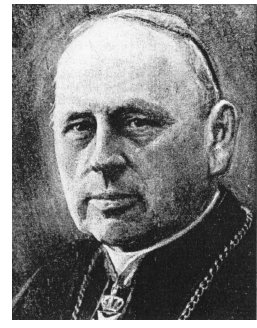Franz Löbmann

was born on 14/1/1856 in Schirgiswalde (Upper Lusatia), the oldest of the carpenter Joseph Löbmann's and his wife Emilie Döring's five children.
After being prepared by the deacon in his home parish and a short preparatory stay at the catholic teachers' seminary in Bautzen, he went to the Kleinseitner School in Prague as a pupil of the Wendisch seminary. After his school leaving examinations in 1876 and one year's military service as a volunteer in 1876-77 he studied theology in Prague, and in 1880 he went on to study philosophy in Leipzig, preparing for a high level career as a teacher.
On 15/10/1881 he was ordained a priest and first worked as a deacon in Leutersdorf, in the district of Zittau, and Schirgiswalde, and in 1887 he became headmaster of the cathedral school in Bautzen. In 1891 the Chapter of Bautzen Cathedral appointed him head of the teachers' seminar, which post he held for 23 years during which he set up a new house and set exemplary standards. In 1899 he became an honorary canon and in 1905 a residentary canon in Bautzen. After the death of Bishop Schaefer, on 5/11/1914 the Bautzen Chapter elected him dean and thus the Apostolic Prefect of Lusatia. Papal confirmation and the appointment as Titular Bishop of Priene and as vicar apostolic of Saxony followed on 30/1/1915.On 25/3/1915 Löbmann was consecrated by Prince Bishop Bertram in Breslau, because the Ministry for Cultural Affairs expressed concern about holding the ceremony in Bautzen or Dresden.
Löbmann's time in office was marked by the First World War which led to a noticeable migration of catholic industrial workers away from Saxony. Nevertheless Löbmann managed to expand the network of missions a little and even built four new churches and chapels. Despite the cutting back of Jesuit Law by Reich's Law, the orders' activities remained banned in Saxony. With intensive spiritual guidance Löbmann linked charitable care. In 1917 he visited the front to inspect catholic spiritual guidance in the Saxon army. Even as a bishop he produced publications on educational questions.
After the First World War the church's sovereignty within the state was lost, and Löbmann took the initiative of resurrecting the see of Meissen in Saxony and the Thuringian areas which belonged to the vicar apostolic. He gave the task of setting it up to the redemptionist Joseph Watzl who had been working since 1915 on the history of the chapter in Bautzen for its 700th anniversary in 1921. Since the legal links between the property and income of the catholic church in hereditary matters had been unclear since 1919, Löbmann and the chapter suggested setting up the see with its seat in Bautzen again and to elevate the collegiate church of St.Peter to a cathedral and the monastery chapter to a cathedral chapter. The chapter declared it was prepared to make a considerable part of the Episcopal endowment available, as well as rooms for administering the diocese. Löbmann never saw his plan realised. He died on 4/12/1920 in Bautzen and was buried locally in the St.Nicholas Cemetery. The rebuilding of the see of Meissen is mainly down to him.